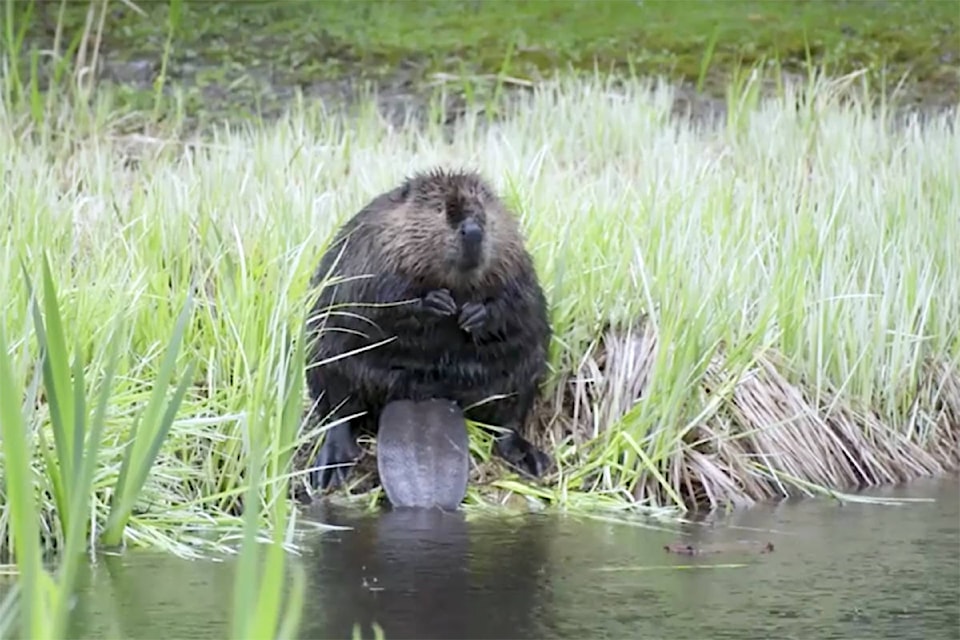Social media lit up with photos and comments last week when a young girl was seen attempting to walk a beaver off of the Agassiz Rosedale bridge.
Agassiz resident Haley Hodgkinson was driving home on April 30 when she noticed the beaver attempting to cross.
“I couldn’t turn around so I waited till I got to the bottom of the bridge to turn around and go back,” she told the Observer via Facebook message. Hodkinson’s mom got in the driver’s seat while the animal lover cautiously made her way to the frightened critter.
“I didn’t want it to get hit so I tried my best to get it back go the other side of the bridge,” she recalled. “I casually walked with [it] back down the bridge, keeping my distance so I wouldn’t scare it. Lots of people drove by taking pictures and pointing. I’m glad people slowed down and made sure to drive by safely!”
Hodgkinson almost had the beaver back across the bridge, but it had grown more aggressive and scared as other people joined the rescue effort. Hodgkinson decided she had done her best, and hoped the beaver would head back into the river.
“We had got it pretty far back down the bridge so we hoped it would just keep going but it was determined to get to the other side.”
Unfortunately, the beaver was later reported to have been hit by traffic when it attempted again to cross the bridge.
While the internet-famous beaver’s story ended in tragedy, it begs the question, what would cause a beaver to make such a risky journey onto the narrow and traffic-heavy Agassiz Rosedale Bridge?
Hope Mountain Centre program director Kelly Pearce said we shouldn’t dismiss the possibility that this was a human-involved incident. A beaver was recently found in the Okanagan shot with four arrows and somehow still alive.
“People do cruel things to wildlife and I wonder if there was human factor in getting him on to that bridge…because it’s very bizarre behaviour for a beaver,” said Pearce.
If humans weren’t involved in the Agassiz beaver’s fateful adventure, then it may have been looking for new habitat and simply made a bad choice along its journey. Still, beaver’s rarely put themselves at risk like this one did.
“They typically stay close to water, they forage around the edge of their ponds,” said Pearce.
Sometimes juvenile males will “disperse” or travel long distances – up to 270 kilometres – in search of a new habitat. This usually occurs when their home pond, lake or riverside has been depleted of food resources.
“The colony will kick out juvenile males and say ‘go get your own habitat, we’re running out of food here!’” Pearce explained. “And that’s a time of great risk for them because they’re in strange territory, they’re away from their home pond and they’re safest in water.”
But even a dispersing juvenile male beaver wouldn’t be likely to attempt crossing a bridge.
“It would be much safer for him to cross the main stem of the Fraser – even in high water levels. He’s a darn good swimmer; he can hold his breath for up to 15 minutes, he can travel a kilometre under water, he doesn’t have to stay at the surface, he could have crossed the Fraser quite easily by swimming.”
Hope for beavers
While this beaver’s story ended sooner than it should have, Pearce said that, generally speaking, things have been looking up for Canada’s beloved critter.
North American beavers have returned to almost all of their original range after being aggressively trapped and hunted during Canada’s early days of fur trading and the Hudson’s Bay Company.
“Beaver populations are doing well, even in urban areas,” said Pearce. “Sometimes they move into municipal parks and reak a lot of havoc but they’re just doing what beavers love to do, which is improve their home and create their own wetlands.”
Call the experts
Whatever caused the beaver to end up on the Agassiz Rosedale Bridge, Pearce’s advice for helping distressed wildlife is to do your best to protect it – if possible, and call B.C. Conservation. Many animals, when scared, can hurt the people trying to help them. Even beavers.
“A cornered beaver could be a very formidable animal. They’re not carnivores of course, but they will defend themselves,” said Pearce.
As we head into summer, more and more wildlife will start appearing in human-filled, and potentially dangerous locations.
“Wildlife activity is on the increase at this time,” said Pearce. “All the birds are coming back from the tropics, the bears are coming out of hibernation. Critters are on the move.”
To report a conflict with wildlife that threatens public safety call 1-877-952-7277.
